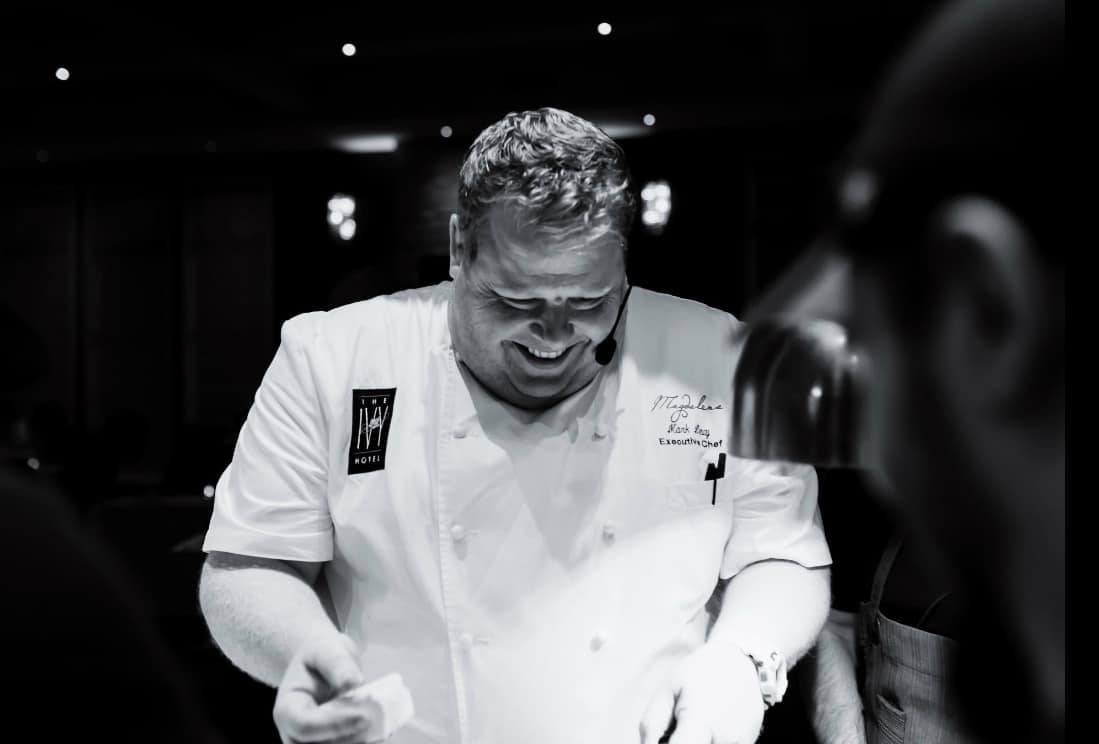
After a seven-month hiatus from his post as the executive chef at Magdalena inside Mt. Vernon’s Ivy Hotel, Mark Levy is more than ready to get back into the kitchen. “It’s been an interesting seven months,” he says. “I took advantage of the time and played a lot of golf. In July, I hit my first-ever hole-in-one.” In addition to playing golf, Levy has been busy refining a new concept and regionally inspired menu for Magdalena—now named Magdalena, A Maryland Bistro—which is reopening on October 9. The focus, says Levy, will be casual, with carryout also available. “I always wanted people to come in five, six times a year, but at that price point, it was more like twice a year,” Levy says. “Now, I hope we will see a lot more people.”
We spoke with Levy about turtle soup, bistro cooking, and his first-ever snowball experience.
Take me back to mid-March, as you were closing the restaurant. Did you have any idea it would be such a long haul?
I had taken a vacation and went home [to England]. I was in Rome with my family and I pulled out because I was concerned about getting back to the States. I came back from my vacation, and within five days of being back, we were closed. We knew it was coming. It was pretty awful, as it was for everyone else.
Why did you decide to change the concept?
Once the dust had settled, we saw an opportunity to do something different that would be more relevant with the current climate. We talked a lot about what the new concept was going to be. I’ve been doing fine-dining for 12 years now, and for eight of the 12 years prior was doing gastropub work and rustic bistro food, so it was really quite natural for me to go back to something that I was already successful at. It was natural to switch the products from 75 percent international and national and 25 percent local and just flip that on its head to 75 percent local and 25 percent national and international. I said, “Let’s simplify and change the price point, and let’s be a little more rustic and more from the heart instead of the brain this time.” We put together six or seven goes to get the menu right, but trying to move away from a more fine-dining mentality was trickier than I thought. Once we got that together, I started making trips to the Eastern Shore and to local farms to see what we could do at Magdalena.
“I said, ‘Let’s be more from the heart instead of the brain this time.’”
All restaurants have a shelf life and organic evolution. Do you agree with that?
Fifteen years ago, my ego would have gotten in the way and I would have said, “Like it or leave it,” but to get a second bite of the cherry, to keep my job and work in this beautiful hotel and kitchen, I’m one of the luckiest blokes out there.
Post pandemic, will we see less fine-dining spots?
I’ve been told that fine-dining is dead for the last 20 years—that’s all you hear people say. Then you get people in Chicago, like Curtis Duffy [who just opened Ever.] It’s always going to have a place. There is probably going to be less of it, but it’s never going to die.
Can you talk about how you developed the regional side of the menu?
The first thing was finding the right products to see what was available. Sometimes the idea of Maryland food is quite obvious with Berger cookies, crab cakes, and snowballs, and I said, “Let’s dig a little bit deeper.” I picked up a book called My Favorite Maryland Recipes by Helen Tawes and found some really interesting stuff. I looked up turtle soup. I knew I wouldn’t be serving turtle, but it allowed me to really see that history of the Eastern Shore, not just Maryland. When the terrapins were all gone, they’d use a veal head. I decided to come up with my own version using veal cheeks and have the same flavor profile as this thing that was made 100 years or so ago.
I didn’t want to flood the menu with all of these things, but I thought there would be a couple of nice dishes that we could keep on for people to get a true taste of—like the Southern Maryland-stuffed ham, where they would stuff the collard greens inside it. So we will come up with a version of that. There are also little touches of England, like fish and chips and some classic French stuff. That’s how I feel the balance is going to work. There will always be crab on the menu—we have a crab cake and will continue to play with crab. I’m good friends with the people at The Brewer’s Art and we are going to use Beazly for the beer batter, so there’s a little piece of Maryland in there, as well.
“Sometimes the idea of Maryland food is quite obvious with Berger cookies, crab cakes, and snowballs, and I said, ‘Let’s dig a little bit deeper.’”
Did you have to redo the kitchen?
Being a bistro, we had to do fries, so we ordered a new fryer. We also added a snowball machine. We are going to wait until summer to really get that going. This summer was the first time I ever ate one. I was pleasantly surprised. I like the chocolate and the marshmallow and the crushed ice. I’m like, “I don’t know why this works, but it’s delicious.” We might do a few alcoholic versions for the bar and we’re going to use the ice from the machine for oysters, as well.
Why did you want to focus on sourcing locally?
The main drive is that I keep hearing how farmers are struggling. I wanted to support them.
There are plenty of other Chesapeake-focused eateries in the Baltimore area. How will Magdalena stand out?
It’s going to be a bistro, but we are still Magdalena—we are inside of The Ivy Hotel and Relais & Châteaux. As a rule, you want to experience the terroir of where you are. I really feel this works hand-in-hand with the hotel, the history of the building, Baltimore, and Maryland—that’s the big difference is that we are a hotel and not just a freestanding restaurant.
“To get a second bite of the cherry, to keep my job and work in this beautiful hotel and kitchen, I’m one of the luckiest blokes out there.”
How does the décor carry the narrative?
We wanted to brighten the room and for it to be less busy. It feels a lot fresher and younger now and the color scheme is oyster, whiskey, and sage. To have a bistro, you have to have a certain buzz. We wanted it to feel like a luxury bistro.
Why do restaurants matter?
Eating out is one of the last truly romantic things you can do. There’s nothing else like it. You sit down, you put your phone away, and you truly enjoy the food—it’s an escape.
